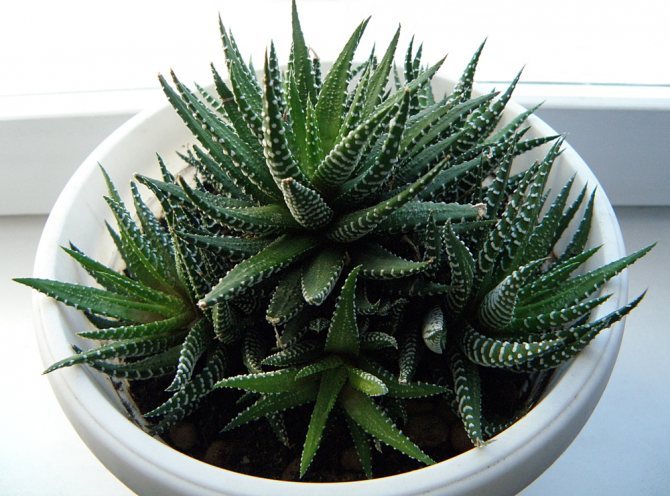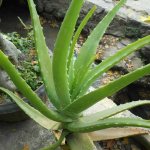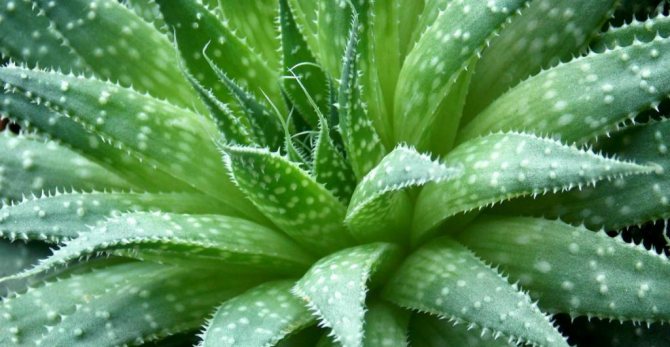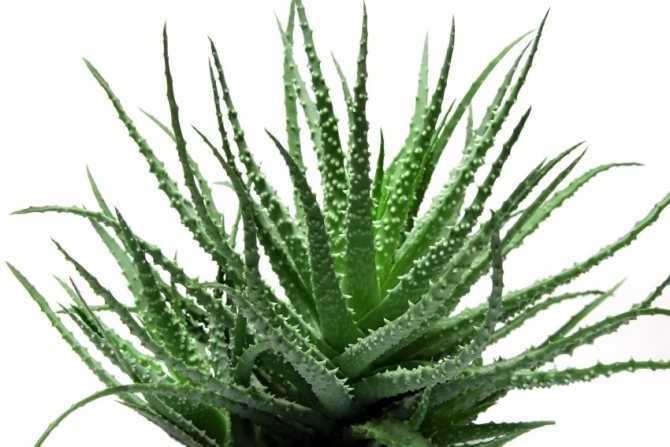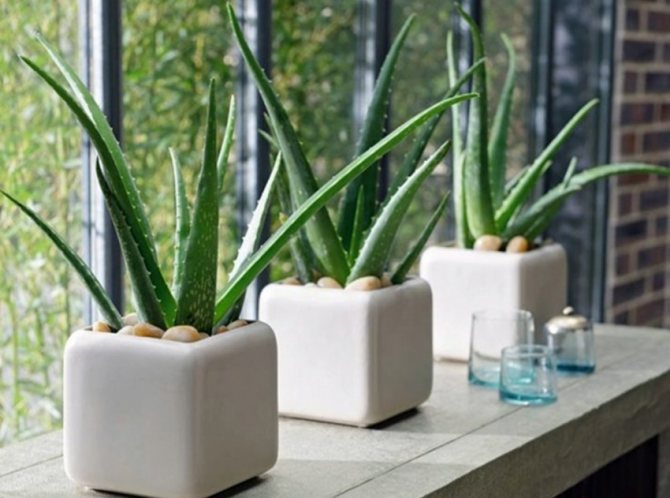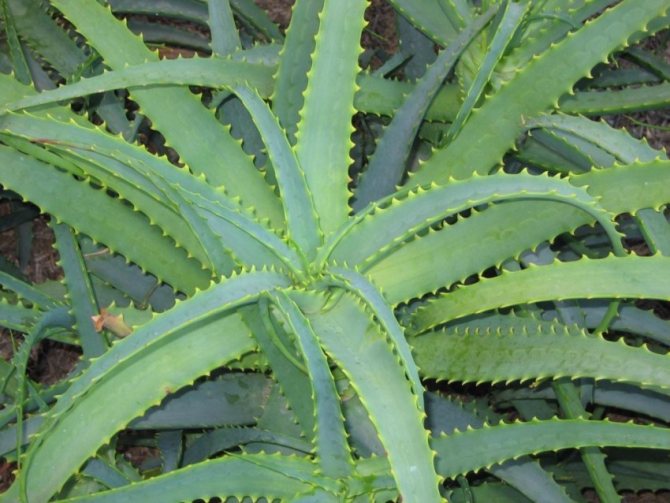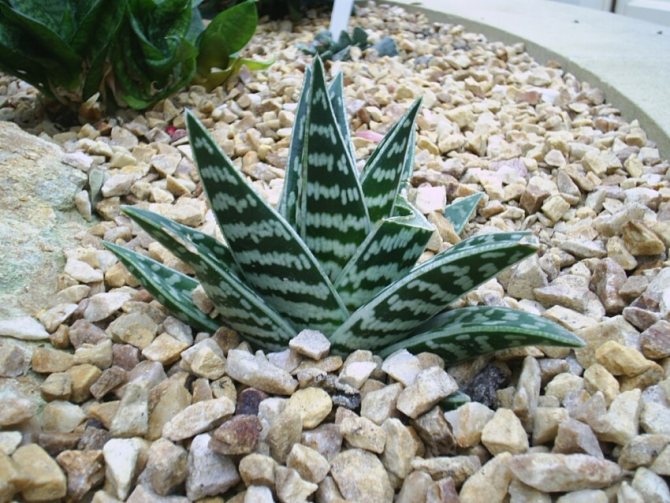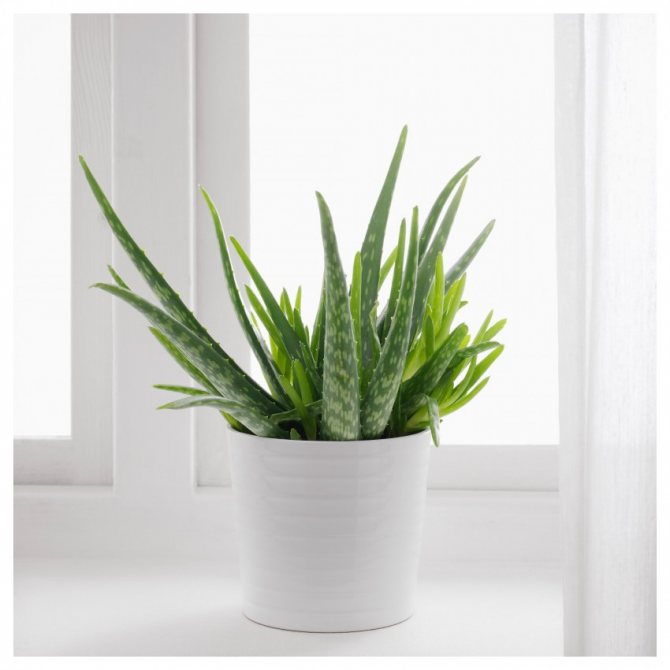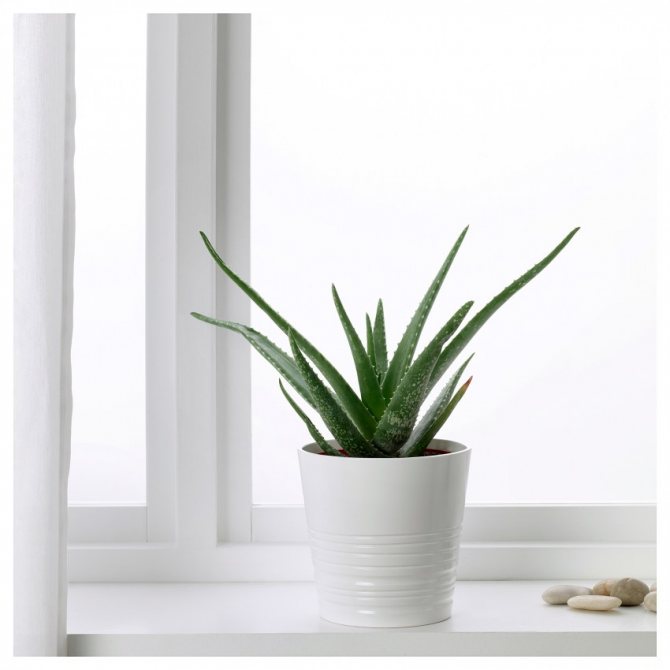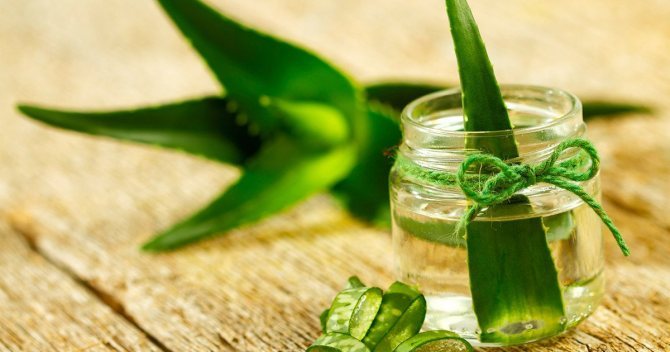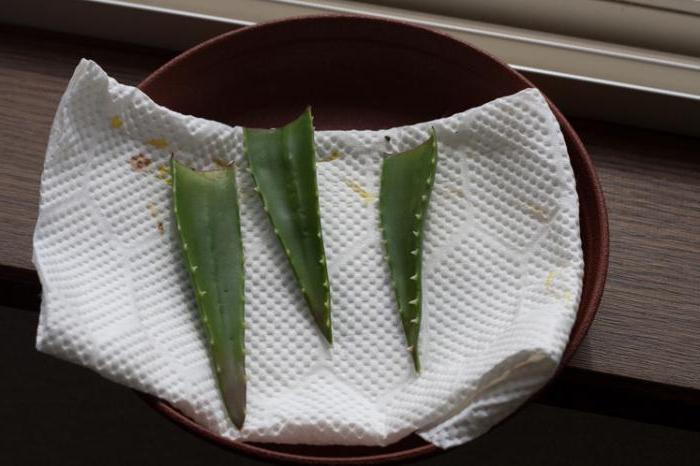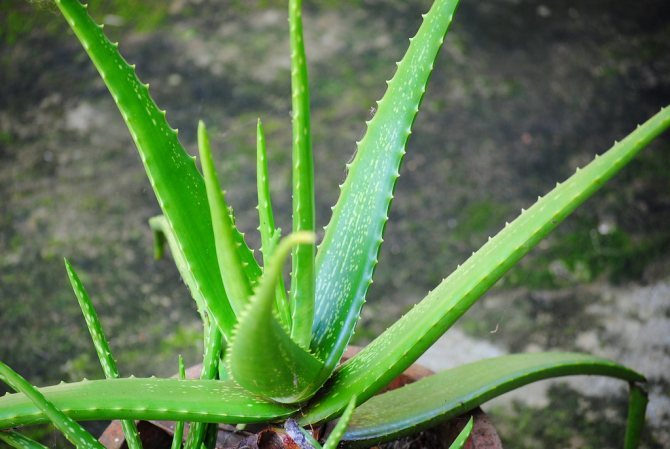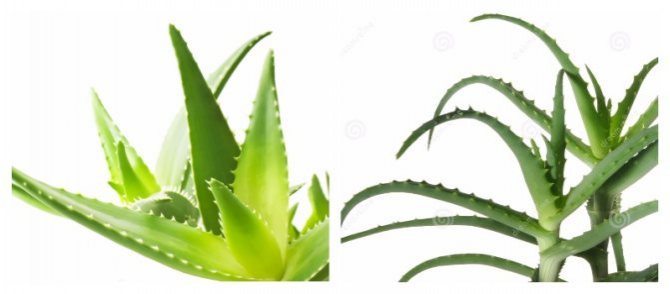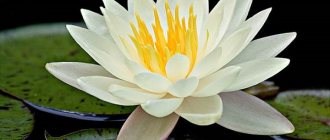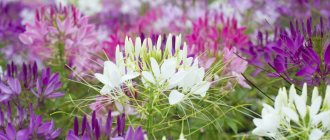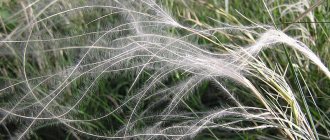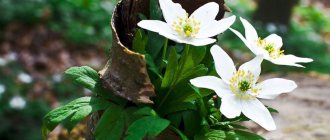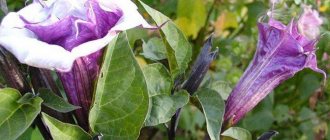Posted in Succulents, Care Published 06/13/2018 · Comments: · Read: 7 min · Views: 3 886
The aloe flower is considered one of the most unpretentious succulents grown in indoor floriculture. The tree-like, or agave, is familiar to many from childhood. The plant lived on the windowsills of many city apartments and rural houses and has always proved to be a reliable first aid if someone in the family was injured - a cut or abrasion.
It seemed that aloe was growing by itself, he did not need care at home - he watered and transplanted. However, ignorance of the basic rules for keeping a medicinal perennial can cause serious damage to it, or even completely destroy it. How to properly care for aloe at home? It is necessary to sort it out in order so as not to lose this useful indoor flower.
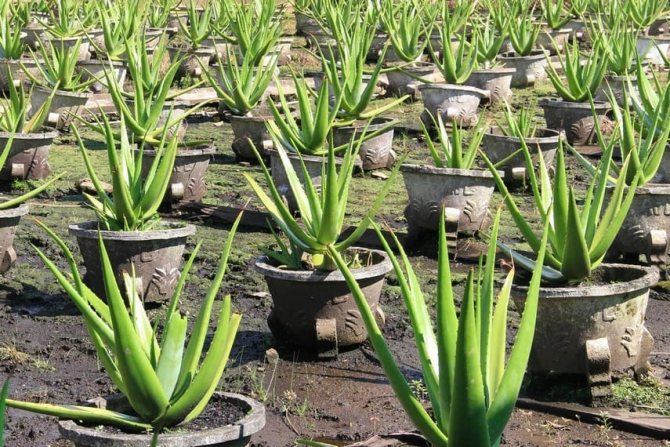
Description
In nature, aloe blooms once every 2-3 years, in pots - once every 10-20 years. Flowering occurs mainly in the spring, but it also happens in the summer. For medicinal products, the flower is grown on extensive plantations. In fact, indoor aloe vera flower grows well at home, but rarely pleases with inflorescences.
A characteristic feature of all succulents is thick xiphoid leaves that grow densely from the trunk in all directions. There are small thorns along the edges of each leaf, and their top layer may have a harmless white coating. The root system of aloe is poorly developed.
The collection and accumulation of moisture, characteristic of this genus, occurs through the leaves. Among the varieties there are tree-like plants reaching 10 meters in height and small bushy representatives of the family.
Aloe care
At home, the plant is picky and does not make any special demands on itself. The main thing is not to overfill it, but also not to dry it out, to adhere to a reasonable watering regime. In summer, aloe is usually watered once a week, in winter, when the succulent is dormant, once a month.
How to water a plant
Watering from above is used with caution, watering along the wall of the vessel, and not under the very root neck. You should beware of water getting inside the rosette of leaves. If, through inattention, moisture still got into the depths of the leaf axils, you must thoroughly blot it with a dry napkin.
For the plant, watering from the bottom into the pan is more suitable. The succulent will take as much water as it needs, but the rest must be drained. Stagnation of water in the pan is extremely harmful to the flower - it leads to rotting of the root system and the death of perennials.
Spraying for aloe is optional. High humidity is not needed for it, the plant in its natural habitats - in South Africa and the Arabian Peninsula - is accustomed to the dry air of savannas and deserts. In too hot weather, it is advisable to place a vessel with water next to the plant. By evaporating, it will weaken the effect of heat on the flower.


Aloe food
To replenish the supply of nutrients in the soil mixture, fertilizer is used for cacti and succulents. Top dressing is carried out from mid-spring to the end of autumn several times during the growing season; during dormancy, aloe is not fed.
Florists should be reminded that the plant is watered before feeding so that the root system does not suffer from excessive exposure to nutrients and does not get burned. Fertilizing aloe is better on a cloudy, cool day or when the sun is already rolling towards sunset.
Many succulent owners practice feeding with folk remedies - a solution of sugar, eggshells crushed into powder, water after washing cereals - rice, buckwheat and others, infusion of onion husks.
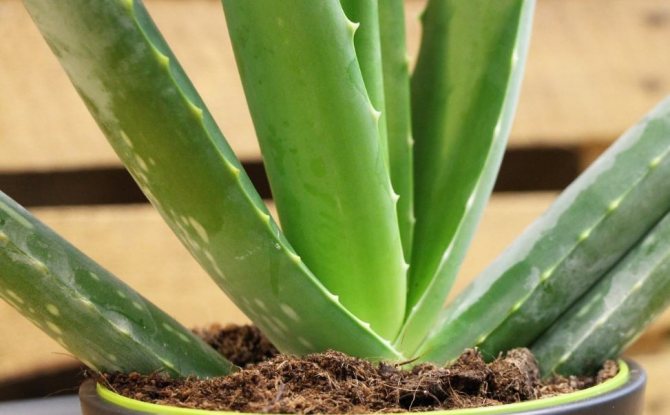

Do you need pruning aloe
A similar question is of interest to more than one grower, especially if the plant grows, grows old. Many are wondering when to prune aloe for medicinal purposes.
It is advisable to use leaves for making aloe juice cut from specimens not younger than 3 years old, even better from five-year-old flowers. To do this, cut off the lower leaves at the base with a sharp tool, put them in the refrigerator for a week to start the biostimulation process in them, only then prepare aloe juice from the leaves.
The leafy shoots of the tree-like aloe look extremely unaesthetic, so they are cut off, the tops are rooted and new plants are obtained, and young shoots grow from the cut stumps, forming a neat, lively bush.
Many other types of succulent require sanitary pruning of aloe vera when all old and damaged leaves are removed. It is best produced at the end of the dormant period. After wilting of the inflorescences, the flower-bearing stems are cut off at the very base.
Root offspring and stem cuttings should also be cut in a timely manner so that they do not pull forces from the mother plant, and during transplantation they prune the roots - they remove those that have died out during dormancy, damaged and rotten, if any.
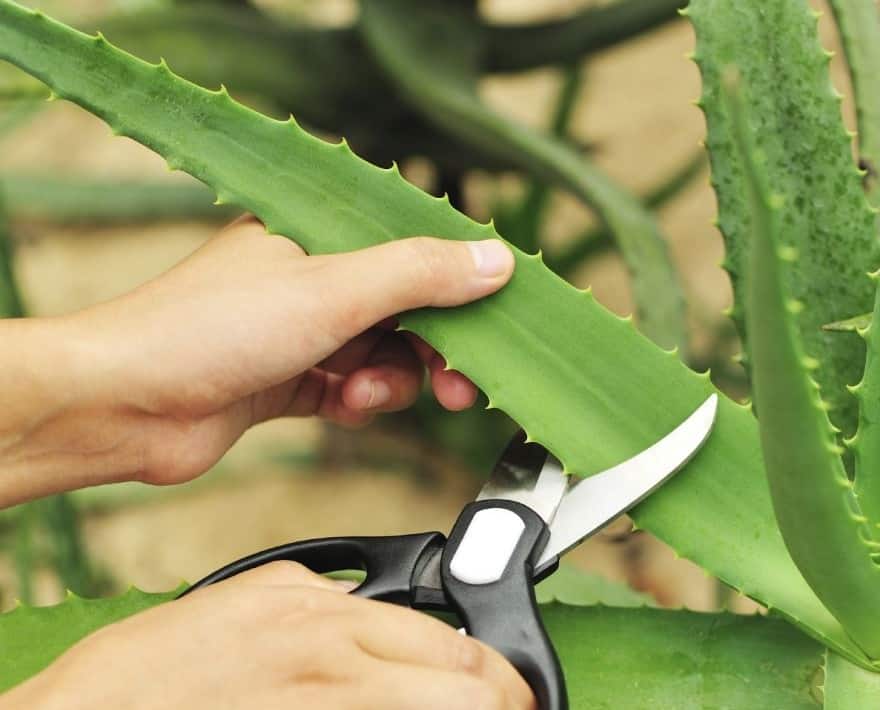

Landing and lighting
The aloe vera flower should be planted in clay containers because the clay will absorb excess moisture from the ground. A high drainage layer is a prerequisite, because stagnant water can lead to rotting of the root system.
The plant is rather unstable. Several small stones around the base help to strengthen and support the plant, which grows every year. In summer, the succulent should be taken out into the open, because the ultraviolet rays necessary to grow a powerful stem and thick fleshy leaves do not pass through the glass.
The plant loves the sun, so the recommended planting site is a windowsill on the south or southeast side. If the aloe does not have enough UV light, it stretches. In winter, it is recommended to use additional lighting. As you can see from the recommendations, special care is not needed for aloe vera.
In spring and summer, during increased solar activity, the plant should be shaded, otherwise burns will appear. To do this, use tulle or gauze. Shade for about a week until "getting used to".
Conditions for keeping aloe
Succulent is very photophilous. For him, the most illuminated place in the apartment is chosen, as a rule, this is the sill of the south window. The plant is not even afraid of direct sunlight, under which its leaves acquire a slightly pinkish tint or have a bluish bloom.
Of course, it is still better to protect it from strong sunshine in 30-degree heat, but the air temperature is 22-26 degrees above zero for aloe is quite comfortable. However, the flower prefers to endure the dormant state in winter in cooler conditions - about 16-18 degrees Celsius, not lower than 10 degrees. The cooler it is in the room where the aloe is, the less watering it will need.
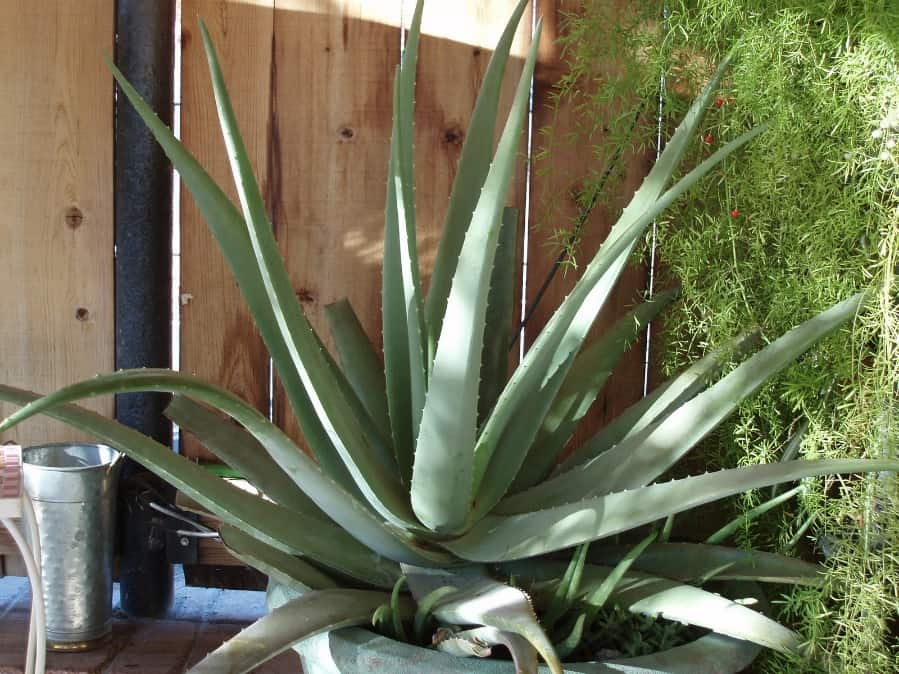

Temperature and watering
For aloe vera flower, home care consists in regular moderate watering with water at room temperature. The plant can be taken out onto the balcony, but care must be taken so that no precipitation falls and there are no drafts.In winter, aloe practically "sleeps", so you should put it in a dark, cool place with a temperature of no more than +14 degrees.
Proper watering is practically all care for aloe vera so that the plant grows healthy. The soil should be irrigated as the top layer dries up, and in winter, twice less often. Make sure that moisture does not get into the outlet with leaves - this will lead to rotting of the trunk.
The most common flowering species
Aptenia care and reproduction: varieties and conditions of home keeping
There are approximately 300 known flowering varieties of this succulent. Most of them open their buds in the spring or early summer. The most popular types:
- Aloe Vera - blooms with bright orange flowers and is considered the most common in indoor floriculture.
- Fan-shaped - its leaf plates are arranged accordingly, and the buds are colored red.
- Aloe Jackson - differs in purple-violet tube flowers.
- Aloe Descoings - in this variety, the leaves are triangular, and the buds are yellow in color.
- Aloe tree - it is characterized by a variety of flower shades - bright red, light yellow, rich orange and pink.
- Camperi - differs in a branched peduncle, at the ends of which there are brushes with scarlet buds.
- A pretty aloe - its bell flowers have a purple-coral hue.
- Soapy - tubular buds of this type are colored in red, yellow or pink tones with a speck of a darker shade.
- Frightening (it is also Terrible) - thorns on leaf plates and bright orange-scarlet inflorescences are considered a distinctive feature of the variety.
- White-flowered is the rarest indoor species, it came from Madagascar and is distinguished by white-cream buds.
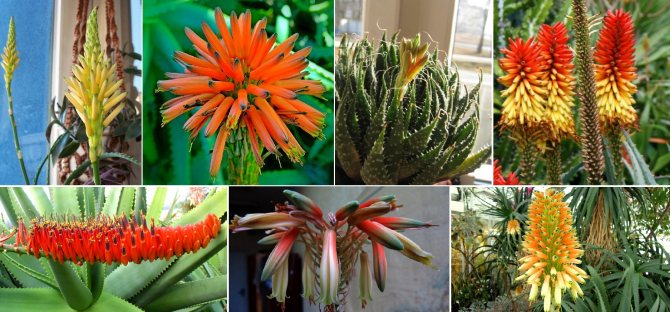

Inflorescences of different types differ in color and shape
Seed propagation
After flowering, cotyledons appear on the aloe. After waiting for ripening, they are sown in containers filled with soil mixture. To create the soil, we take sand, turf and leafy soil (2: 1: 1).
It is not worth replanting fragile sprouts - be patient. When the young aloes are strong, prepare separate containers for them. The soil should be the same in composition, but with the addition of brick chips and charcoal.
Further care for young aloe vera consists of regular watering. The next spring, the plants are transplanted into spacious pots. The aloe vera flower is homemade, the benefits are obvious, since it not only disinfects the air, but also acts as a green first-aid kit.
Types and varieties
Aloe spinous
Spinous aloe resembles a small, stocky bush, its leaves are slightly wider than those of other plant varieties. It is distinguished by small white ostines - thin growths on the outer and inner sides of the leaves.
Care features:
- requires abundant watering;
- in winter it must be in a room with a temperature not lower than 18-20 ° С;
- the absence of peat in the soil is desirable;
- does not need frequent spraying;
- loves intense lighting (if it is not enough from natural light sources, then it is better to install several special lamps).
- Despite its "plump" appearance, spinous aloe is a very fragile plant, and when transplanting it, you need to proceed with extreme caution.
Aloe vera
The most common subspecies of aloe. Outwardly, it is a rather high dense stem with wide cone-shaped leaves extending from its base. There are elastic spines along the edges of the leaves, which lignify if the plant is more than 5 years old.
Care features:
- you need to fertilize the plant with organic fertilizers no more than 1 time a year;
- there should be a predominant amount of river sand in the soil;
- does not need additional light sources, feels comfortable on the windowsill even on a sunny day;
- low need for watering.
- Aloe vera differs from its counterparts in its ability to grow intensively, so it will have to be transplanted more often than other succulents.
Aloe Variegated (brindle)
The plant owes its name to its color: it is distinguished by milky transverse wide stripes on green, elongated leaves, somewhat reminiscent of a tiger color. A relatively low succulent, in height it can be no higher than 35 cm.
Care features:
- comfortable wintering temperature - no more than 14 ° С;
- requires good lighting in the room;
- has a weighty and powerful rhizome, requires some effort when transplanting;
- grows best in large, spacious pots.
- A distinctive feature of the variegated aloe is that even in spring and summer (during the period of intensive growth), the plant can feel great at a temperature of 12-15 ° C.
Aloe tree
This type of aloe is called tree-like because it has a wide and long stem that grows upward. The plant can reach a height of more than 3 m, and have a trunk thickness in the girth of about 20 cm. The leaves of the succulent are longer than those of other representatives of the aloe species.
Care features:
- heat-loving plant, the temperature of its content should not fall below 5 ° С;
- needs bright and constant lighting;
- able to reproduce all year round: cuttings are always suitable for planting;
requires regular ventilation.
The tree-like aloe blooms even less often than other species, especially the temperatures uncomfortable for the plant. It is also detrimental for this plant to find it in close proximity to a hot battery.
Other types
- Soapy.
It has a spotted color, a massive and stocky plant. It grows up to half a meter in height and the same amount in width. Lignified spines, up to 0.5 cm long, are located along the edges of the leaves. - Distant.
The leaves of this aloe variety curl towards the center and are ovoid. The plant has no light spots on the outer sides of the leaves. - Short-leaved.
In appearance it resembles a small "hedgehog", has a compact size - no more than 15-20 cm in height with short leaves tightly pressed against each other at the base. - Pretty little.
The succulent got such a touching name because it looks very fragile and delicate against the background of other types of aloe. The leaves of a pretty aloe are thin and long, curling in the opposite direction from the center. Slightly rough leaves have small white specks. - Ciliated.
It has a long thin stem and is a climbing plant. The leaves are thin, fragile, and have pronounced stripes. - Slim.
It has wide, almost flat, spotted leaves that fit tightly together. The ends of the leaves are slightly bent down. The succulent plant does not like bright and constant sunlight, preferring shady places. - Strongly prickly.
One of the largest plants of its kind. Reaches 3-4 meters in height, the leaves have a bluish tint with a whitish bloom. Prefers bright light and infrequent watering. The leaves are dotted with red or crimson teeth at the edges.
Seating
Aloe vera flower tends to grow in height, grow, acquire young shoots. When the container becomes shallow for the plant, it is transplanted into a deeper pot. Young shoots are transplanted into a small container so that they get stronger and gain strength.
Adult plants are planted about once every 3-4 years, young plants - once every 2 years. Drainage is laid at the bottom of the container, then the substrate. After pulling the plant out of the old pot, you should carefully clean the root of excess soil, place it in a new pot and sprinkle it with substrate. Do not forget about small stones to strengthen the trunk.
The soil
In order for the culture to be healthy and beautiful, the soil in the container must be neutral or with a low acidity. For the roots to "breathe" you need:
- gravel;
- charcoal;
- brick crushed to a state of crumb.
You can prepare the soil for aloe yourself. This will require turf, leafy earth, sand and humus. At the bottom of the pot, drainage should first be poured, the layer of which should reach 4 cm, then small stones. This approach will protect the root system from excessive moisture.


Growing problems
At home, aloe vera flower grows well, but due to improper care, a number of troubles can arise. For example:
- With excessive moisture, the leaves wither and lose their color saturation. For the same reason, putrefactive processes of the stem and root system can begin. If this happens, transplant the aloe vera flower into a new pot, inspecting and removing any rot.
- The lack of sunlight stimulates the stretching of the plant, which makes it look ugly. You can compensate for the lack of ultraviolet radiation with fluorescent lamps.
- Insufficient humidity in the air leads to the appearance of brown spots on the tips of the leaves. Ventilate the area with the plant regularly.
- The plant does not like drafts and cold. When airing the area, protect the aloe.
Pests damaging the plant:
- mealybug;
- shield;
- aphid;
- false shield.
Chemicals are used to eliminate pests. The shield is removed with a cotton swab dipped in alcohol, then irrigated with aloe insecticide. It is important to detect in time the dark brown spots characteristic of the appearance of the pest. The aloe vera flower, the photo of which is presented in the article, recovers quite quickly after treatment with chemicals.
To exterminate the spider mite, the plant is treated with an insecticide, taken out into the fresh air and the room is ventilated. It is almost impossible to save a plant from dry rot. Follow the care guidelines to prevent illness.


Diseases and symptoms of improper care
More often, aloe does not suffer from pests, but from improper care. There are several clear signs that a plant is feeling uncomfortable:
- Drying of the stem and leaves, a period of stagnation in growth are symptoms of excessive moisture. This disease is also called root rot. In order to save the plant, it is necessary to remove the damaged segments of the roots and sprinkle the healthy ones with sulfur.
- Sudden drying of leaves and stem. This disease is called dry rot. The disease is dangerous because external signs are not observed for a long time, and then in a few days the aloe dies. However, you can notice the initial stage of development of dry rot if you cut off one of the leaves of the plant. If the leaf is dry on the cut, does not emit juice when pressed, this means that the disease has already affected the plant. Unfortunately, there is only a preventive measure against dry rot: periodic spraying with fungicide.
- Dryness of the tips of the leaves and their yellowing indicate that the aloe needs replanting, and the roots are already lacking nutrients, as the soil is depleted.
- Curling and thinning of the leaves are signs that the succulent lacks light and needs to be cleaned of dust and other contaminants.
- Falling leaves indicate that the water is too cold for irrigation.
- Redness of the foliage indicates that the aloe has received a burn; it should reduce the brightness of the lighting for a while.
Healing properties
Aloe vera leaves contain a full set of vitamins and minerals, due to which they have a complex effect on the body. It is both a drug and a prophylactic drug. In medicine, the outer parts of the stem (sapwood) and the leaves from which the juice is made are used. Succulent inflorescences do not have medicinal properties.
Fresh juice or one stripped off (sabur) are the most effective medicines from aloe. In medical preparations, the plant is less effective due to the use of preservatives, which block some of the nutrients. The benefits of the aloe vera flower have been proven for generations.
To get healthy juice, you need to cut off the lowest, most fleshy leaves and put them in the refrigerator. The recommended time is 10-14 days, during which biogenic stimulants and many more useful substances are produced in the leaves. To prevent the raw materials from spoiling, wrap them in plastic wrap.
Concentrated juice should not be stored longer than 2-3 days, because it oxidizes when it interacts with air. For long-term storage, the juice is diluted with alcohol, and the container for it is sterilized. The container should be chosen dark so that the sun's rays do not affect the contents.
In addition to juice and sabur, plant-based products are used in medicine:
- butter;
- syrup;
- liquid extract;
- ointment;
- gel.
Transplant stages:
- Pour the drainage into a pre-prepared container with a layer of 3 cm.
- Add soil.
- Drizzle.
- Transplant the flower without removing the earthen lump from the roots.
After the completion of the procedure, despite the love of the spinous aloe to the sun, you cannot immediately put it on a well-lit area. Light training should be gradual.
You can change the "place of residence" of a plant unscheduled if:
- parasites appeared in the ground;
- shoots appeared near the stem;
- the roots are bare;
- a lot of dried out shoots.
If you transplant spinous aloe in winter, it can die from stress.
What heals aloe
The complex of nutrients in the plant has a positive effect on:
- cardiovascular, nervous and immune systems;
- the gastrointestinal tract;
- skin.
The healing properties of aloe vera flower:
- has antifungal effect;
- used as an antiviral drug;
- cleanses the body of toxins;
- removes slags;
- increases tone;
- lowers blood sugar;
- restores intestinal microflora;
- accelerates hair growth;
- lowers cholesterol levels;
- prevents hair loss;
- improves blood circulation;
- facilitate the manifestation of allergies;
- relieves pain;
- treats stomatitis;
- heals dental plaque;
- treats gingivitis;
- used for the prevention and treatment of cancer;
- has laxative properties;
- has diuretic properties;
- has antioxidant properties;
- helps in the treatment of respiratory diseases;
- used in gynecology.
The bactericidal effect of aloe juice helps fight such microorganisms:
- staphylococcus;
- streptococcus;
- dysentery stick;
- typhoid stick;
- diphtheria bacillus.
Greenhouse in the country: the pros and cons of different greenhouse designs
A greenhouse is an industrial building designed for the cultivation of thermophilic cultivated plants, vegetables and fruits. Thanks to the retained heat, a favorable environment is created inside the building for the growth and development of horticultural and horticultural crops. … 4 February 2020, 12:10
Root rot
The owner of the plant is almost always to blame for the occurrence of this disease, since excessive watering is the cause. Aloe roots begin to rot, the bottom of the stem also rot, and growth is not observed even with normal care.
If you notice these signs, immediately remove the rotten part of the root, sprinkle the rest of the root with ash. Ash or charcoal can also be added to the soil to prevent further root rot development.
Spider mite
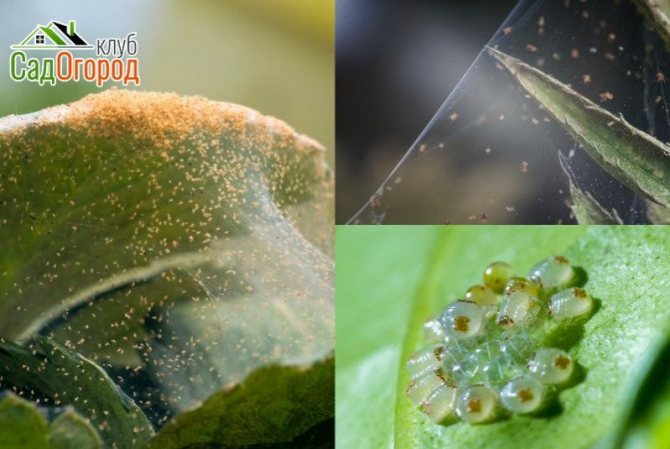

Photo source: Very small (up to 1 mm), but extremely dangerous pest. It is very difficult to see the ticks themselves, but you cannot fail to notice the cobwebs on the leaves. But when the attack of ticks becomes maximum, you can see them on the bottom of the sheet.Another sign of the appearance of mites is a change in the color of the leaves to yellow, and in the last stage to red.
You need to fight the tick immediately, since the pest spreads quickly. Treatment mainly consists of the use of acaricides, and for prevention, try not to forget to periodically wipe the leaves (especially the lower ones) with an alcohol solution.
Aloe vera in cosmetology


In this area, the plant deservedly bears the name of the miraculous elixir. The complex of vitamins contained in the plant has a positive effect on any type of skin. Among the positive qualities, it should be noted:
- gentle cleansing of the skin;
- moisturizing the skin and its antibacterial protection;
- recharge at the cellular level;
- regenerating and healing properties;
- rejuvenates;
- deodorizes;
- slows down aging;
- normalizes metabolic processes.
Aloe vera is known to have positive effects on stretch marks and scars. Cosmetics based on this plant relieve acne, eczema, dermatitis and skin ulcers. Succulent ointments effectively eliminate varicose veins. Also, under the influence of aloe components, the skin is regenerated and renewed faster.
The juice has anti-burn and anesthetic properties, thanks to which it perfectly relieves pain and helps to get rid of the consequences of burns.
Aloe Vera for food
Not everyone knows that succulents can be eaten. Aloe products are sold in great demand abroad. A container with gel, which is extracted from the pulp of the leaves, is popular, and aloe vera is used instead of fruit juices. This is done in the treatment of diseases or to raise vitality.
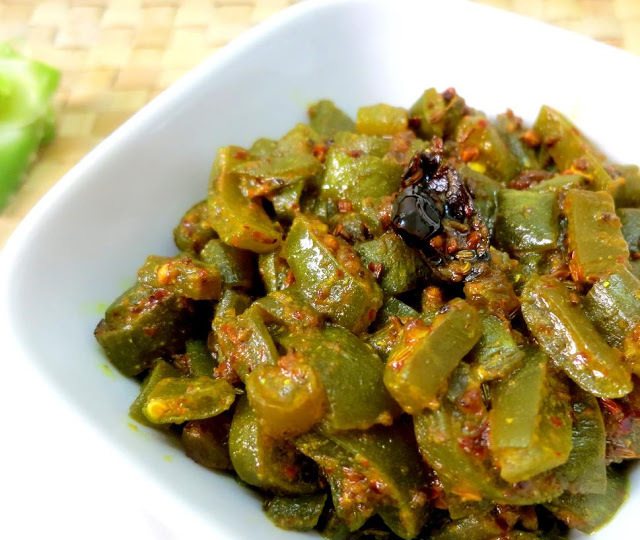

In folk medicine, the peeled pulp of the leaves is used to treat the nervous system. Honey infusion treats diseases of the gastrointestinal tract. Since succulent products are a mild laxative, they are often used to cleanse the intestines and as a weight loss aid.
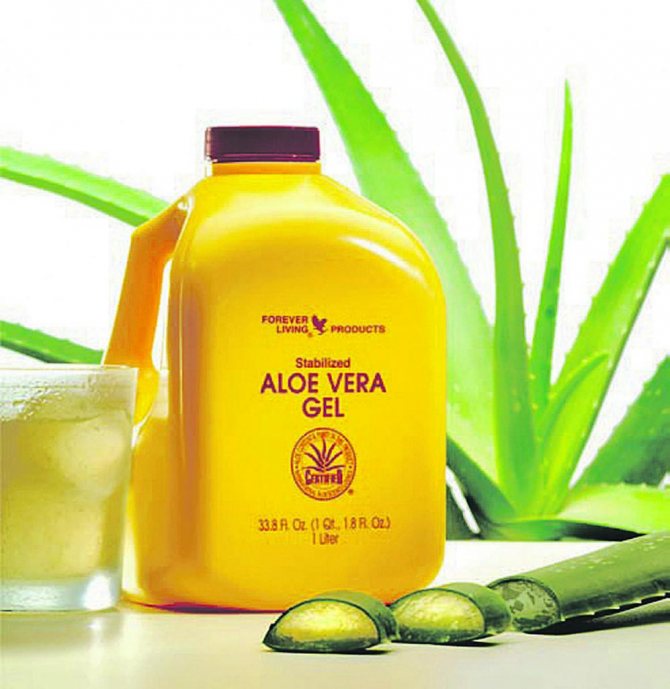

Sabur, gel, aloe cream and soft ice cream are also eaten. Chilled sweetness is sold in European stores and is in unprecedented demand. It is worth remembering that even healthy foods can be harmful if consumed excessively, so you should be careful and consult your doctor about possible dangers.
Contraindications
Aloe vera preparations are not recommended for:
- exacerbated diseases of the gastrointestinal tract;
- internal bleeding;
- cystitis;
- individual intolerance to the components;
- jade;
- hepatitis A;
- severe pathologies of the cardiovascular system;
- cholecystitis;
- pregnancy;
- hemorrhoids.
Healing ointments have fewer contraindications. They can be used by children from one year old and pregnant. Aloe vera is a home flower, its benefits and harms depend on the individual characteristics of the organism. The advantages of the plant were considered, and as for the negative aspects, it should be borne in mind that aloe juice is very caustic. It should be used with caution for mucous membranes, as you can get burned.
Growing aloe vera is a simple process. Just a few simple rules must be followed to keep the plant healthy - moderate watering, adequate lighting and a comfortable temperature. A disease or parasite detected in a timely manner can be eliminated without consequences.
Transfer
The transplant should be carried out annually when it comes to young plants, and once every two years if the flower is already 5 or 6 years old. In the first case, the need for frequent transplantation is the rapid growth of the culture, and therefore there is little space for the roots. The ideal time for the procedure is March-April. For everything to go right, you need a special substrate for cacti. You can make it yourself using:
- leafy ground;
- sand;
- turf;
- drainage from expanded clay.
Mix all components.To obtain the required acidity indicator, add 2 tsp to the resulting mixture. peat add 2 tsp. peat.
